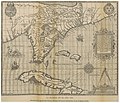Archivo:1591 De Bry and Le Moyne Map of Florida and Cuba - Geographicus - Florida-debry-1591.jpg

Tamaño de esta previsualización: 775 × 599 píxeles. Otras resoluciones: 310 × 240 píxeles · 621 × 480 píxeles · 993 × 768 píxeles · 1280 × 990 píxeles · 2560 × 1980 píxeles · 4500 × 3480 píxeles.
Ver la imagen en su resolución original (4500 × 3480 píxeles; tamaño de archivo: 6,38 MB; tipo MIME: image/jpeg)
Historial del archivo
Haz clic sobre una fecha y hora para ver el archivo tal como apareció en ese momento.
| Fecha y hora | Miniatura | Dimensiones | Usuario | Comentario | |
|---|---|---|---|---|---|
| actual | 19:21 22 mar 2011 |  | 4500 × 3480 (6,38 MB) | BotMultichillT | {{subst:User:Multichill/Geographicus |link=http://www.geographicus.com/P/AntiqueMap/Florida-debry-1591 |product_name=1591 De Bry and Le Moyne Map of Florida and Cuba |map_title=Floridae Americae Provinciae Recens & Exactissima Descriptio Auctore Iacobo Le |
Usos del archivo
La siguiente página usa este archivo:
Uso global del archivo
Las wikis siguientes utilizan este archivo:
- Uso en la.wikipedia.org
- Uso en nl.wikipedia.org
- Uso en ru.wikipedia.org
- Uso en zea.wikipedia.org
